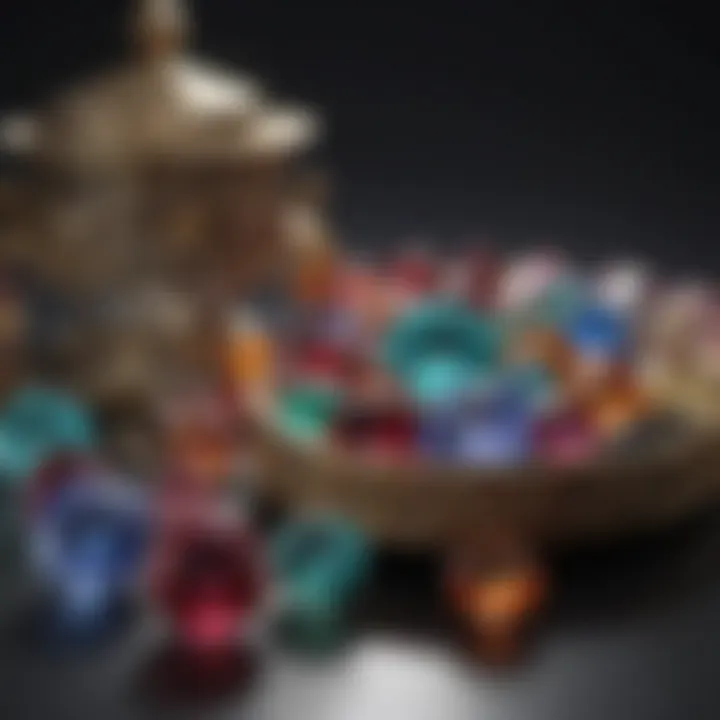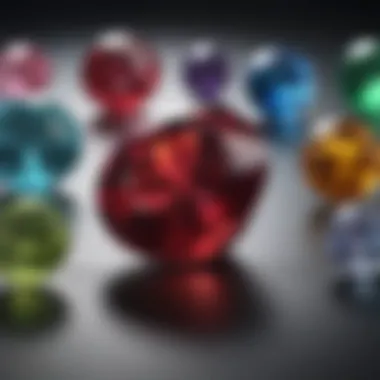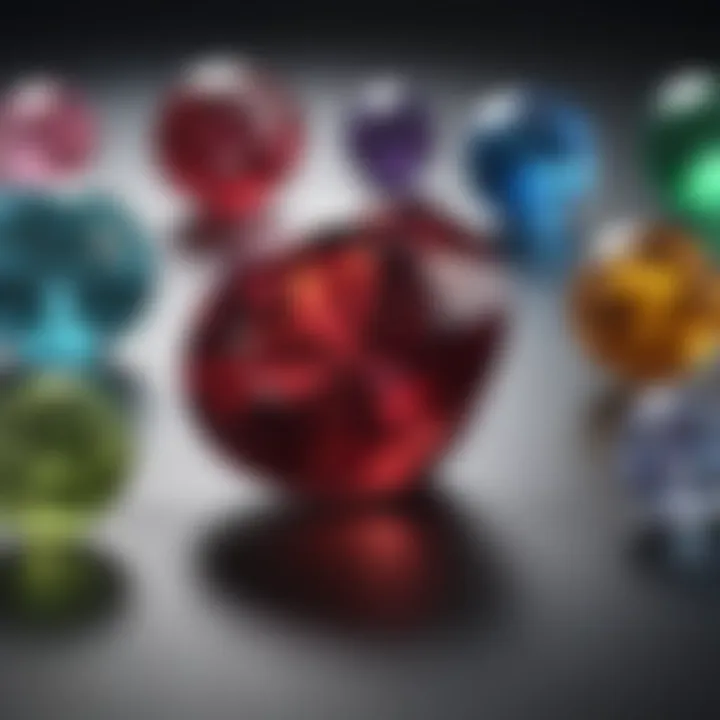Exploring Birthstones: Gems for Every Month


Intro
Birthstones hold a unique place in both personal and cultural contexts. For centuries, these gemstones have been associated with specific months, carrying their own histories, meanings, and properties. Understanding the origin and significance of each stone deepens our appreciation for these natural wonders. This article seeks to unpack the complexities surrounding birthstones, enhancing your knowledge about their beauty, value, and rich cultural narratives.
Gemstone Overview
Definition and Characteristics
A gemstone is a piece of mineral crystal that is cut and polished to make jewelry or other decorations. Each birthstone is a gem that reflects attributes specific to the month it represents. For instance, January is often linked with garnets, known for their deep red hues.
Classification of Gemstones
Gemstones can be classified into two main categories: precious and semiprecious. Precious stones include diamonds, rubies, sapphires, and emeralds. Semiprecious stones comprise a larger group, including amethyst, aquamarine, and garnet. This classification is somewhat traditional, as the value of a gemstone is also determined by factors like rarity, quality, and demand.
Properties of Gemstones
Physical Properties
The physical properties of gemstones include hardness, luster, color, and clarity. Hardness is measured using the Mohs scale, which ranges from 1 (talc) to 10 (diamond). For example, sapphires and rubies, both forms of corundum, score a 9 on this scale, indicating their resilience. Color is another critical attribute; it can vary significantly even within the same type of gemstone.
Chemical Properties
The chemical properties of gemstones reveal the elements that make up each stone. For example, diamond is composed of carbon, while emeralds are primarily beryl, which contains beryllium, aluminum, and oxygen. Understanding these chemical properties allows gemstone enthusiasts and collectors to appreciate the uniqueness of each stone at a molecular level.
"Every gemstone tells a story—its formation, the earth's history, and the cultural significance it has amassed over time."
The End
This comprehensive guide serves as an introduction to the intricate world of birthstones. Understanding their physical and chemical properties lays the foundation for a deeper exploration of each gemstone's unique attributes and its significance throughout history. In the sections that follow, we will delve into the distinct birthstones of each month, revealing the complexities and stories that elevate them beyond mere decoration.
Prelude to Birthstones
Birthstones hold a unique place in human culture and expression, serving as more than mere jewelry. They are intertwined with history, spirituality, and personal significance. The importance of birthstones emerges from their ability to connect individuals to specific times of the year and the meanings assigned to these gems, enhancing their personal value.
Definition and Background
Birthstones are gemstones that correspond to each month of the year, a tradition that has roots in ancient cultures. The practice is often linked to the twelve stones listed in the Book of Exodus, each representing the twelve tribes of Israel. Over time, these stones were associated with the calendar months, evolving into a practice within various cultures that signifies identity and personalization.
In modern contexts, birthstones are often given as gifts, especially during birthdays. The stones are believed to bring good luck, protection, and other benefits to individuals born in the respective months. This belief contributes to their appeal, as each stone carries distinct attributes.
Cultural Significance of Birthstones
The cultural importance of birthstones cannot be overstated. For many cultures, these stones are not just gifts but carriers of meaning and belief. Each month’s stone embodies specific traits and powers. For instance, garnet, the birthstone for January, symbolizes strength and is believed to enhance emotional balance. Similarly, emerald, the May birthstone, is linked to prosperity and renewal.
In various traditions, certain rituals may involve the use of birthstones. They are often worn in jewelry as talismans, serving protective roles or enhancing the wearer’s characteristics. The significance varies across different cultures; for instance, in Hindu tradition, gemstones have astrological meanings that can influence the wearer’s fate.
"Birthstones connect individuals to their month of birth, evoking emotions and memories tied to personal and cultural histories."
In summary, birthstones represent a personal connection to time and tradition. They offer insights into individual identity while also serving broader cultural narratives. As we explore the gems associated with each month, one can appreciate not just their beauty, but the rich tapestry of meaning they embody.
January: Garnet
Garnet, the birthstone for January, serves as a symbol of light and vitality. Its deep hues range from rich reds to vibrant greens, reflecting a diverse palette that captivates enthusiasts and collectors alike. Not just a beautiful gemstone, garnet carries deep historical significance and mythical properties, lending it a place of esteem among precious stones. Understanding garnet's unique qualities provides insight into its enduring appeal and relevance in both personal adornment and cultural contexts.
History of Garnet
The history of garnet dates back thousands of years. Ancient civilizations utilized garnet in various ways, from jewelry to ornamental objects. For instance, it was highly prized in ancient Egypt, where it adorned the tombs of pharaohs. The Romans also valued garnet, often using it as a seal stone, believing it held protective properties. The name "garnet" is derived from the Latin word "granatus," which means seed, likely due to its resemblance to pomegranate seeds.
Throughout history, garnet has been associated with numerous cultures worldwide. For medieval Europeans, garnet was thought to have protective qualities against nightmares and to enhance productivity. It is especially celebrated in the Middle Ages for its ability to ward off evil and symbolize loyalty in love.
Mythical Properties of Garnet
In addition to its historical significance, garnet is surrounded by various mythical properties. Traditionally, it is believed to possess healing qualities, providing strength and vitality to its wearer. Some cultures view garnet as a stone of fire, symbolizing passion and energy.
Garnet is also thought to inspire love and commitment, which is why it is often given as a gift between partners.
"Garnet is not just a birthstone; it is a talisman that connects its bearer with life force and passion."
Garnet's vibrant energy is thought to align with the root chakra, which governs stability and security. This makes it a perfect stone for those seeking grounding and balance in their lives.
February: Amethyst
Amethyst, known for its deep purple hue, is the birthstone for February. This gemstone holds a significant place in various cultures and is deeply woven into traditions. The allure of amethyst is not just in its beauty but also in the rich history and profound meanings attached to it. This section will explore the cultural associations and healing properties of amethyst, providing insights that go beyond surface aesthetics.
Cultural Associations with Amethyst
Amethyst has a long-standing history that spans several civilizations. The ancient Greeks believed that amethyst could ward off drunkenness, calling it "amethystos," which translates to "not intoxicated." This historical belief has contributed to its association with temperance and self-control. The stone was often used in ceremonial regalia and adorned by the elite, including royalty, who valued it for its supposed protective properties.


In the context of modern society, amethyst is considered a stone of wisdom and tranquility. Many see it as a catalyst for spirituality, encouraging a deeper connection to oneself and the universe. Amethyst is also linked to the crown chakra, which symbolizes higher consciousness and divine connection. This connection has led to its use in meditation practices.
Beyond spirituality, amethyst plays a role in various cultural rituals. For instance, in some cultures, it is believed to bring peace and calmness to households. Wearing amethyst jewelry may be seen as an amulet against negativity and a way to attract positive energy. Such beliefs highlight the enduring importance of this gemstone across generations.
Healing Properties of Amethyst
Amethyst is often touted for its healing properties, which are said to be both physical and emotional. Many practitioners of alternative medicine claim that amethyst can alleviate stress, anxiety, and emotional imbalance. Its calming influence is believed to promote a sense of peace, making it particularly beneficial for individuals dealing with tumultuous situations.
Some proponents suggest that amethyst's vibration helps in detoxifying the body and can act as a natural antiseptic. This has led to its use in various holistic healing practices. Furthermore, amethyst is said to enhance memory and improve motivation, which makes it appealing for students and professionals alike.
It is also thought that amethyst can improve sleep quality, making it a popular choice for those who experience insomnia. By placing an amethyst stone under a pillow or on a bedside table, it is believed to promote restful sleep and vivid dreams.
"The calming affect of amethyst can assist one in finding stillness amidst chaos, making it a valuable tool in today's fast-paced world."
In summary, amethyst is more than just a beautiful gemstone. Its rich cultural associations and reputed healing properties contribute to its unique status among birthstones. For gemstone enthusiasts, collectors, and jewelry designers, understanding both the historical and modern context of amethyst adds depth to its appreciation. This multifaceted gem remains a timeless symbol of clarity, peace, and emotional balance.
March: Aquamarine
Aquamarine is a gemstone that holds a special place in the list of birthstones. Known for its stunning shades of blue and green, it embodies the essence of the ocean. The lore surrounding aquamarine goes beyond its beauty; it connects deeply with various cultural beliefs and practices. In this section, we highlight both the mythical narratives and modern uses, showcasing how aquamarine captures the intrigue of history and the present.
Mermaid Legends and Aquamarine
Aquamarine has long been associated with mermaids and sea mythology. Ancient sailors believed that the gemstone was the treasure of mermaids, offering protection during long voyages. The ocean blue color of aquamarine perfectly mimics the hues of the sea, which is thought to have mystical connections.
In many cultures, the aquamarine stone was seen as a talisman of safety. It is said that carrying or wearing aquamarine can ward off dangers at sea. Also, it is associated with the water element, which is why many stories portray mermaids bestowing this gem to worthy sailors.
Some tales suggest that aquamarine can enhance communication, making it easier for one to express their true thoughts and feelings. This quality links the stone to the water's flow, emphasizing clarity and depth in conversation. Through these legends, aquamarine continues to symbolize harmony and courage.
Modern Applications of Aquamarine
In contemporary times, aquamarine has transcended its storybook origins, finding a significant place in jewelry and therapy. Jewelry designers highly value aquamarine due to its unique color and durability. The stone is particularly favored for engagement rings and other fine jewelry.
In addition, aquamarine is believed to provide therapeutic benefits. It is known to ease feelings of stress and anxiety. Many practitioners of crystal healing advocate for the stone's use in meditation to promote a sense of tranquility. This lends aquamarine a dual role: as a fashionable accessory and a source of emotional support.
Key Takeaways
- Aquamarine is linked to maritime legends, particularly mermaid stories.
- It symbolizes protection and comfort for sailors.
- In modern jewelry design, it is appreciated for its beauty and durability.
- The stone is also utilized in crystal healing practices for its calming properties.
Aquamarine remains more than just a birthstone; it embodies a cultural heritage intertwined with beauty and utility.
April: Diamond
Diamonds hold a unique status among gemstones, particularly for the month of April. Their reputation is intertwined not only with beauty but also with rarity and cultural significance. As the birthstone for April, diamonds symbolize strength, endurance, and invincibility. This section delves into the distinct characteristics of diamonds, providing a deeper understanding of their allure and importance.
The Rarity of Diamonds
The formation of diamonds is a complex geological process that occurs under intense heat and pressure deep within the Earth's mantle. This rarity contributes to their high value. Not all diamonds are created equal. Various factors influence their characteristics, known as the Four Cs: Cut, Color, Clarity, and Carat weight.
- Cut refers to how well a diamond has been shaped and polished. A well-cut diamond reflects light beautifully.
- Color ranges from colorless to light yellow or brown. Colorless diamonds are typically more valued.
- Clarity indicates the presence of internal or external flaws, which can affect a diamond's value.
- Carat weight measures a diamond's size. Larger diamonds are generally rarer and more sought after.
Diamonds are mined in various locations, including South Africa, Russia, and Australia. The mining process itself is resource-intensive. As a result, the rarity of diamonds is not just about their formation but also about the limited availability of ethically sourced gems. Thus, the appeal of diamonds extends beyond their physical beauty to encompass their significance in terms of investment and rarity.
Cultural Significance of Diamonds
Diamonds have captivated humanity for centuries, embedding themselves deeply in cultural narratives. In many societies, they symbolize love and commitment. This connection is perhaps best exemplified by the tradition of using diamonds in engagement rings. The phrase "a diamond is forever" reflects this bond, indicating an eternal promise.
Around the world, diamonds are often associated with power and status. Historically, they adorned the crowns of monarchs and were worn by the elite. In contemporary times, celebrities often wear diamonds at events, solidifying their position as symbols of wealth and sophistication.
In some cultures, diamonds are believed to possess healing properties and bring positive energy. They are thought to enhance relationships and bring clarity of thought.
The cultural narrative of diamonds goes beyond mere aesthetics. Diamonds encapsulate a heritage of affection, power, and unity across civilizations.
In summary, diamonds are not only significant as the birthstone for April but represent devotion, rarity, and cultural importance. Their implications in the realms of love and status ensure that they remain revered across various cultures and generations.
May: Emerald
Emerald, the birthstone for May, carries a rich tapestry of significance, resonating through history and culture. This gemstone is celebrated not just for its captivating hue but for its profound meanings and properties. The importance of emeralds lies in their historical reverence and their aesthetic desirability in both ancient and contemporary jewelry. Their vibrant green shade symbolizes rebirth and love, making them particularly cherished during the spring season.
Historical Use of Emeralds
Emeralds have been treasured since antiquity. Records show that the ancient Egyptians held emeralds in high esteem, associating them with fertility and prosperity. These gemstones were frequently buried with their owners as a sign of their value in the afterlife. Cleopatra, the iconic queen of Egypt, was famously known for her collection of emeralds, further solidifying the gem's royal connection.
In addition, emeralds played a significant role in ancient Rome, where they were believed to bring foresight and preventive safety. Roman aristocrats adorned themselves with emeralds, linking them to influences of power and prestige. Similarly, in various South American cultures, emeralds were considered sacred, enchanted stones that held divine qualities.
Thus, the historical footprint of emeralds is both deep and extensive, cementing their place in various cultures as an emblem of wealth and spiritual significance.
Emerald in Modern Jewelry


In today's market, emeralds hold a noteworthy position as one of the most sought-after gemstones in luxury jewelry. Their appealing brightness and distinctive color have made them a staple choice for a variety of jewelry items, including rings, necklaces, and bracelets. Jewelry designers often favor emeralds due to their versatility, which pairs well with both gold and silver settings.
Emeralds are also increasingly being featured in bespoke jewelry pieces, allowing for personalized designs that enhance individual expression and style. Many collectors pursue high-quality emeralds with a focus on clarity and cut, as these factors significantly influence value. Moreover, the Emerald Cut, which showcases the gemstone's vibrant color characteristics, remains a popular choice among artisans.
Emeralds are not just beautiful; they carry a legacy that speaks to the heart of human civilization.
The demand for ethically sourced emeralds is rising, leading many designers to focus on sustainable practices. This reflects a broader trend towards conscious consumption within the luxury market, appealing to consumers who prioritize both beauty and ethical integrity in their purchases.
In summary, the emerald's profound historical roots and its prominent role in modern jewelry underscore its timeless allure. Whether viewed through the lens of history or contemporary fashion, emeralds will continue to shine as a symbol of elegance and cultural richness.
June: Pearl
The pearl, as the birthstone associated with June, holds a unique position in the world of gemstones. Unlike most other birthstones that are formed in mineral-rich environments, pearls are organic jewels, formed within living mollusks. This distinctive formation sets pearls apart in terms of both their composition and their significance. Their delicate beauty and shimmering luster make them a cherished choice for jewelry lovers and collectors alike.
Formation of Pearls
Pearls form through a natural process involving mollusks, primarily oysters and mussels. When an irritant, such as a grain of sand or a small parasite, enters the shell of a mollusk, the creature responds by secreting layers of nacre, a combination of aragonite and conchiolin. This layering continues over time, gradually forming a pearl. The quality of a pearl is influenced by various factors, including the type of mollusk, the environment in which it resides, and the duration of the formation process.
Interestingly, pearls can also be cultured through human intervention. In pearl farming, technicians introduce an irritant into the mollusk to stimulate pearl production. This method allows for the creation of pearls with desired characteristics, such as size, shape, and color. Cultured pearls dominate the market today, with notable examples being Akoya pearls, Tahitian pearls, and South Sea pearls.
Cultural Iconography of Pearls
Throughout history, pearls have been deeply revered across various cultures. Often associated with purity, wisdom, and wealth, they hold prominent places in both art and mythology. In ancient Rome, pearls were considered the ultimate symbol of status and were often worn by nobility. Cleopatra famously claimed to dissolve a pearl in vinegar and drink it to prove her wealth.
In Asia, particularly in China, pearls are viewed as symbols of protection and are often featured in folklore and traditional jewelry. They are believed to bring good fortune and prosperity to their wearers. In Christianity, pearls are frequently associated with the teachings of Jesus, particularly in the parable of the Pearl of Great Price, symbolizing the kingdom of heaven.
"Pearls are the result of nature's efforts to heal, a reminder that beauty is born from adversity."
Today, pearls continue to be incorporated into modern jewelry designs. They are often paired with gold and silver to create sophisticated pieces that balance elegance with a timeless feel. From necklaces to earrings, pearls fit seamlessly with various styles, making them a staple in both everyday and high-fashion jewelry.
July: Ruby
Rubies hold a prominent position in the realm of gemstones. This section offers a deep exploration into the historical significance and rich symbolism associated with this eyedropping stone. The ruby’s vibrant red color has captivated many across cultures, making the birthstone of July not just a decorative item, but a symbol of deep emotional and historical value.
Historical Importance of Rubies
Rubies have a long and storied history that dates back thousands of years. One of the first references to rubies can be traced to ancient civilizations. The people of Burma, now Myanmar, believed that the ruby would guarantee safety in battle and was often worn by warriors as a talisman. The extraction of rubies from Burma has been an important part of their economy for centuries.
In Europe, during the Middle Ages, rubies were associated with nobility and were usually set in crowns or used in royal jewelry. Their rarity and beauty made them a symbol of wealth and power. Furthermore, the belief that rubies possessed magical properties added to their allure. Medieval Europeans thought that these stones could provide peace and happiness to their owners.
The use of rubies also spread throughout Asia. In Hindu culture, rubies are considered to signify love and passion, revered for their beauty and how they can enhance energy and passion. Indeed, these attributes have allowed rubies to maintain their status as a highly sought-after gemstone over centuries.
Symbolism of Ruby
The ruby is often referred to as the "king of gemstones". Its symbolism varies culturally but maintains a core theme of passion, love, and power. The deep red hue of the ruby is commonly associated with the heart, making it a popular gift between lovers. It signifies desire and bravery, representing a kind of emotional vitality that many wish to embody.
**"A ruby is not just a gem; it represents a treasured emotional bond and invigorating energy."
In addition to love, rubies symbolize protection and prosperity. Many cultures hold the belief that rubies bring good fortune and guard their owner from misfortune. In some traditions, the gemstone is thought to bring good health and vitality.
In jewelry design, the ruby's striking appearance allows it to stand out, whether in ornate rings or simple necklaces. Its vibrant tone ensures the ruby remains a crucial part of collections by gemstone enthusiasts and jewelry designers alike.
The allure of rubies continues to thrive today. For many, the ruby serves as both an aesthetic marvel and an emblem of deeper values. Its historical backgrounds combined with its symbolism make this gemstone a complex and rich topic worthy of exploration in any detailed guide about birthstones.
August: Peridot
Peridot, the birthstone associated with the month of August, holds a unique place in the world of gemstones. Known for its distinct green hue, it is one of the few gemstones that occur in just one color, showcasing shades that range from yellowish-green to olive green. This characteristic reflects its formation process and connection to geological phenomena. Understanding Peridot's geological aspects as well as the rich folklore surrounding this stone provides valuable insight into its significance.
Geological Aspects of Peridot
Peridot is a magnesium iron silicate mineral that belongs to the olivine family. Its formation can occur in two primary environments: within the Earth’s mantle and in volcanic ejecta. The mineral typically crystallizes in a kind of igneous rock called peridotite, which is found deep within the Earth’s crust. The unique green color is primarily due to the iron content within the crystal structure.
Interestingly, peridot can also be found in meteorites, which suggests a cosmic origin. This extraterrestrial connection adds an intriguing layer to its geological narrative. The Paratacamite deposits in Pakistan and the Island of Zabargad in the Red Sea are well-known sources for obtaining high-quality peridot.
The process of extracting peridot from these sources can be both challenging and rewarding due to its location in volcanic regions. As a result, this gem is not just a representation of earthly beauty but also a product of geological forces that have been at play for millions of years.
Myth and Folklore of Peridot
Peridot's appeal extends beyond its physical properties; it is steeped in rich folklore and mystical attributes. Ancient Egyptians referred to peridot as the "gem of the sun". They believed that the stone had healing qualities and could protect against nightmares and evil spirits. This connection to the sun symbolizes its bright, vibrant energy meant to bring warmth and clarity.
In various cultures, peridot is associated with prosperity and happiness. Some traditions hold that wearing peridot brings luck, especially in matters of the heart. The stone is thought to enhance emotional strength, encouraging positivity and emotional balance.
"Peridot is not only seen as a beautiful stone but also a powerful talisman that connects wearers to joy and abundance."
September: Sapphire
Sapphire is not just a gem associated with September; it embodies a rich tapestry of history, folklore, and scientific inquiry. The allure of sapphire extends beyond its breathtaking hues, often symbolizing wisdom, loyalty, and nobility. In this article, we focus on significant aspects of sapphire, including its types, historical relevance, and cultural impact. Engaging with sapphire allows enthusiasts and collectors to deepen their appreciation of this remarkable gemstone.


Types of Sapphires
When discussing sapphires, it is essential to recognize their diversity. Sapphires come primarily in a vibrant blue shade but can exhibit a range of colors based on their mineral composition. Here are several notable types:
- Blue Sapphire: The most well-known variety, highly esteemed for its deep blue color, which is often associated with royalty.
- Yellow Sapphire: Known for bringing prosperity and generally has a lighter yellow hue.
- Pink Sapphire: A representation of romance, pink sapphires can range from pastel to vivid shades.
- Green Sapphire: Less common, green sapphires convey a unique earthiness.
- Star Sapphire: Characterized by a star-like phenomenon on its surface, making each piece distinctive.
This variety allows for personal expression among collectors and jewelers alike, leading to various uses in engagement rings, necklaces, and other forms of jewelry.
Sapphire's Historical Relevance
Historically, sapphires have held great significance across various cultures and epochs. In ancient Persia, sapphires were believed to protect against envy and harm. They were thought to represent the heavens and were woven into royal insignias, symbolizing divine favor. In the Middle Ages, clergy adorned themselves with sapphires, believing that these stones brought them closer to God, imbuing them with purity and foresight.
"Sapphires, historically seen as symbols of wisdom and virtue, have adorned crowns and robes of monarchs for centuries."
Moreover, sapphires have been noted in various myths. For instance, in Hinduism, yellow sapphires are associated with the deity Jupiter, thought to bestow wisdom and fortune. Similarly, in the Western world, the gemstone continues to capture the imagination of many, maintaining its position as a favorite in bridal jewelry due to its durability and timeless aesthetic.
As a result, sapphires remain a symbol not only of beauty but of deep cultural and historical resonance, enriching the narrative of gemstones throughout the ages. Understanding these historical facets enhances the appreciation for sapphire far beyond its physical beauty.
October: Opal
Opal holds a unique position among the birthstones. It is often regarded as a stone of transformation and inspiration, making it particularly significant for those born in October. Opals are not just visually stunning; they are known for their play of colors, which can represent the diverse spectrum of human emotion. This month’s gemstone encapsulates a blend of mystery and beauty, providing meaning that extends beyond physical appearance.
The Science Behind Opals
Opals are fascinating geological formations. They are composed primarily of silica, a common mineral found in nature. Unlike most gemstones that form in a crystalline structure, opals exist in a non-crystalline form. This distinctive structure results in their characteristic play of color, known as opalescence.
- Silica Spheres: Within opals, silicate spheres arrange themselves in a grid-like pattern, which diffracts light. The size and spacing of these spheres affect the color and intensity of the light that exits the stone.
- Hydration: Opals can contain a significant amount of water—ranging from 3% to 21%, depending on the type. This property can influence their appearance and durability.
- Types of Opal: There are several varieties of opal, such as Precious Opal, which exhibits the play of color, and Common Opal, which lacks this feature. Each type has its own value and significance in cultural contexts.
"Opals carry a depth of mystery, connecting the seen and unseen worlds."
Opal's Place in Gemstone Lore
Throughout history, opals have ignited imaginations and adorned royalties. There is an abundance of lore surrounding these gems, often associating them with various powers and meanings.
- Historical Associations: In the past, opals were considered a symbol of purity and hope. Ancient Romans revered them, believing they contained the virtues of all gemstones.
- Cultural Significance: In some cultures, opals were thought to bring good luck and protection. However, in the Middle Ages, they gained a negative reputation, as they were said to bring misfortune to anyone who was not born in October.
- Modern Views: Today, opals are revered as representations of originality and creativity. They encourage emotional healing and enhance one's imagination, qualities that are especially valued in artistic circles.
Overall, October’s birthstone reveals a complexity that resonates with many. Its intricate visual charm, combined with the deep-rooted significance it carries, offers both aesthetic appeal and personal meaning. Understanding the science and lore of opals enhances their appreciation beyond mere decoration, showcasing them as stones of emotional and cultural heritage.
November: Topaz
Topaz, the birthstone for November, holds a significant place in the world of gemstones. It is appreciated not only for its physical beauty but also for the meanings and historical narratives attached to it. Understanding topaz provides insights into its symbolism, unique characteristics, and the ways it has reverberated across cultures. This section will cover both the physical characteristics of topaz and its place in cultural narratives, showing how this gemstone continues to capture interest and admiration.
Physical Characteristics of Topaz
Topaz is a silicate mineral composed of aluminum and fluorine, and its crystalline structure contributes immensely to its visual appeal. Found primarily in igneous rocks like granite, topaz is one of the hardest gemstones available, scoring an 8 on the Mohs hardness scale. This durability makes it an excellent choice for everyday jewelry.
In terms of color, topaz can be found in a range of shades including:
- Colorless
- Blue
- Yellow
- Pink
- Brown
- Green
The most popular and prized color is the blue topaz, which is often heat-treated to enhance its hue. The stone exhibits remarkable clarity and brilliance, especially when well-cut.
Moreover, topaz can display a phenomenon known as pleochroism where it appears to be different colors depending on the angle of observation. This characteristic adds another layer of allure to this gemstone.
Topaz in Cultural Narratives
Historically, topaz has varied cultural significance across different regions. Ancient Egyptians believed the stone was colored by the golden rays of the sun, associating it with the sun god Ra. It was often used as a protective amulet, believed to ward off harm and promote love. This is not unique to Egypt, as many civilizations across history have attributed protective qualities to topaz.
In contemporary culture, topaz is linked with themes of communication and personal expression. It is believed to aid in clear thinking and creativity. Moreover, the stone’s healing properties are sometimes invoked in the context of emotional balance, making it sought after in esoteric practices.
"The significance of topaz extends beyond mere aesthetics, acting as a bridge between personal emotion and cultural history."
In modern jewelry design, topaz remains popular for various styles. It serves as a centerpiece in extravagant necklaces, elegant rings, and dazzling earrings. Whether incorporated in bridal jewelry or used in statement pieces, topaz's versatility keeps it relevant across time.
December: Turquoise
Turquoise, recognized as the birthstone for December, embodies a unique depth of history and symbolism. This gemstone stands out not only for its vibrant blue-green hue but also for its rich cultural and historical significance. It holds a prominent position in various civilizations, esteemed for both its aesthetic qualities and its supposed metaphysical properties. Understanding turquoise involves examining its formation, historical uses, and the various beliefs surrounding its effects on
Culmination: The Timeless Appeal of Birthstones
The examination of birthstones reveals their significance across history and cultures. Birthstones are not merely beautiful adornments; they carry deep meanings and connections to identity. This article has discussed the uniqueness of each gem, how they resonate with personal stories, and their place in modern society.
The Future of Birthstones
As we advance, the appeal of birthstones evolves. Consumers are increasingly interested in personal narratives about gemstones. There is a growing blend of tradition with modern preferences, where individuals seek more than just aesthetic qualities. Instead, they look for stones that resonate with their personal journeys. Future trends might include personalization in gemstone choices, as people are likely to select birthstones based on personal significance rather than just birth month representation.
Moreover, technology may play a role. Augmented reality applications could allow potential buyers to visualize how a stone looks before purchasing. These innovations could deepen connections between gems and their owners, enhancing the emotional bonds people have with their stones.
Evolving Perspectives on Gemstones
Attitudes towards gemstones are shifting. There is a growing awareness of ethical sourcing and sustainable practices in the gem industry. More consumers demand transparency about where and how gemstones are obtained. This trend reflects larger societal movements towards ethical consumption. Many now seek jewels that reflect their values, making informed choices that align with their personal ethics.
Additionally, the rise of lab-created gemstones is changing perspectives. These stones offer identical physical properties but come with fewer environmental impacts. They provide an accessible and ethical alternative to their natural counterparts. The growing acceptance of these stones indicates an ongoing transformation in how people view gemstones in general.
In summary, the timeless appeal of birthstones is influenced by their rich history, emotional connections, and evolving perspectives on ethics and sustainability. Birthstones continue to tell stories both personal and cultural, remaining relevant in today’s world.



